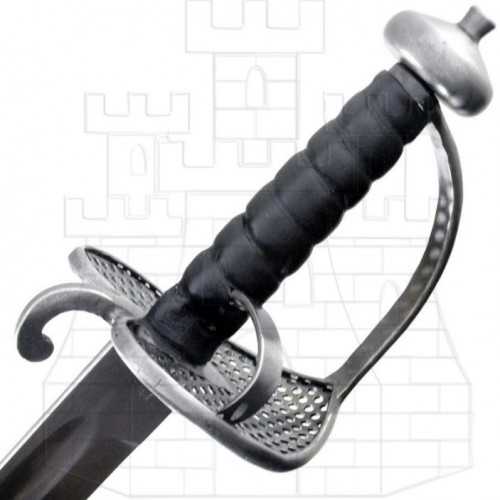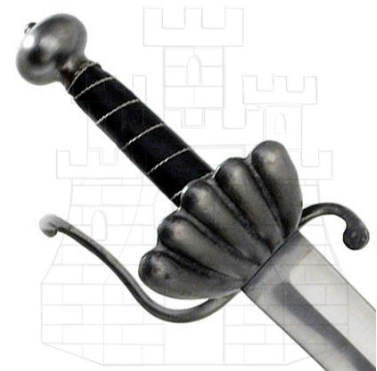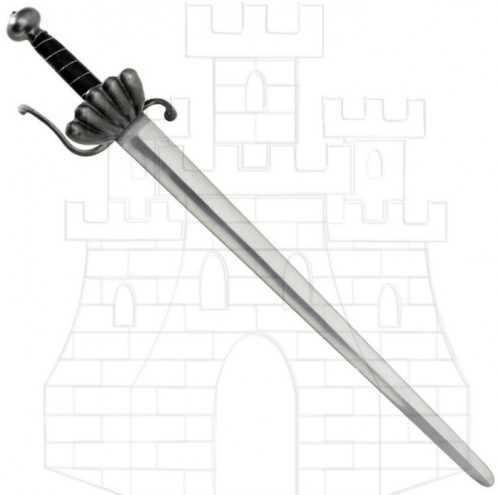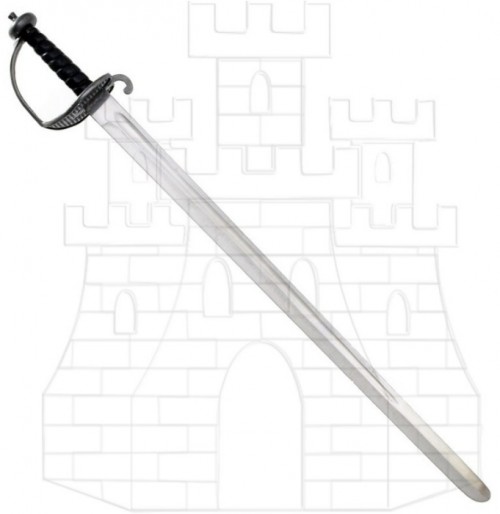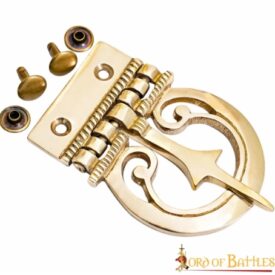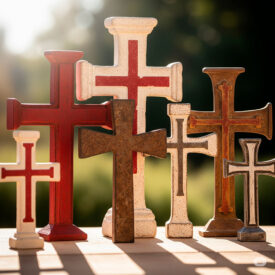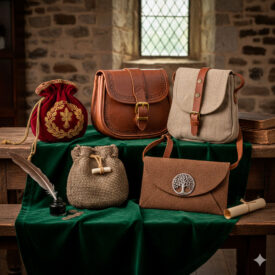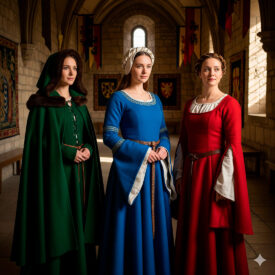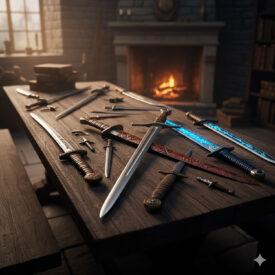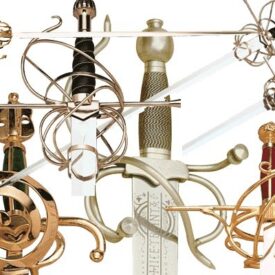Imagine the chandelier-lit court, the velvet whispering with each step, and the clinking of steel that not only cuts but declares status. Baroque swords emerged in that setting: a cross between a weapon, a jewel, and a social symbol. In this article, you will explore why the Baroque sword ceased to be merely a tool of war to become an emblem of honor, style, and artisanal mastery.

A Change of Era: From Field Steel to Court Accessory
In the Baroque era, war and fashion separated: firearms dominated the fields, while the sword found its kingdom in the city, in squares, and in salons. This transition was not mere decadence; it was a transformation that drove innovations in design and ornamentation, adapting the sword to duels, fencing, and exhibition.
Essential Chronology: Milestones from the Medieval Sword to the Civilization of the Weapon (14th–18th Centuries)
The following table organizes the milestones that connect the technical evolution of weapons with changes in clothing and society. Use it as a reference to place the Baroque sword within a broader historical narrative.
| Date | Event |
|---|---|
| 14th Century | |
| Early 14th C. | The oldest preserved fencing treatise, MS I.33, describing techniques with sword and buckler, is dated. |
| 14th Century | Appearance of the hand-and-a-half sword (bastard sword or longsword) as a response to plate armor. |
| 14th Century | Life and transmission of the teachings of Johannes Liechtenauer, a key master of the German fencing tradition through cryptic verses. |
| 15th Century | |
| Early 15th C. | The oldest preserved Italian treatise, by Fiore dei Liberi, is written. |
| 15th Century | First mention of the term “rapier” to designate swords intended to be carried with civilian clothes. |
| 1478 | The Catholic Monarchs create the position of “Maestro Mayor” to certify fencing masters. |
| 1482–1487 | Filippo Vadi writes De Arte Gladiatoria Dimicandi; influenced by Fiore and the first author to emphasize the importance of geometry in fencing. |
| 16th Century | |
| First half of 16th C. | Popular use of the hand-and-a-half sword in Italian territories and the Holy Roman Empire; in Spain, the fencing tradition was practiced mostly by middle classes. |
| 1532 | Francisco Román, the Emperor’s master-at-arms, writes a treatise that has been lost. |
| 1552 | Paulus Hector Mair compiles numerous books and decides to write three treatises in German and Latin to prevent the loss of the art of the sword. |
| 1553 | Camillo Agrippa publishes Trattato di Scientia d’Arme, aimed at a general audience and defending reason in dueling; decisive influence on Italian and Spanish fencing. |
| Mid-16th C. | Emergence of the “Bolognese school” and the “Florentine school” in Italy. |
| Second half of 16th C. | Decline in the use of the hand-and-a-half sword, being replaced by the rapier. |
| 1560 | Demonstration of fencing masters with *montantes* in Toledo during the queen’s entry. |
| 1570 | Joachim Meyer publishes Gründtliche Beschreibung der Kunst des Fechtens, the first printed fencing treatise in German. |
| 1582 | Jerónimo Sánchez de Carranza publishes De la Filosofía de las Armas y de su Destreza…, establishing the “Verdadera Destreza” (True Skill). |
| 17th Century — Weapons and Clothing | |
| Early 17th C. | The Hispanic Monarchy enacts laws to reduce the lethality of weapons: prohibition of duels and regulation of sword size and type. |
| 1600 | Luis Pacheco de Narváez returns to Madrid with his Libro de las Grandezas de la Espada. |
| 1610–1643 | Reign of Louis XIII in France; changes towards absolutism and new court attire. |
| 1618–1648 | Thirty Years’ War, context influencing techniques and weapons. |
| 1624 | Pacheco is appointed Maestro Mayor by Philip IV. |
| Mid-17th C. | The rapier is replaced by the smallsword; the French school of fencing gains popularity. |
| 1692 | The “à la Steinkirk” knotted cravat originates during the Battle of Steinkirk. |
| 1700 | Oriental influence in informal masculine attire: use of “robes de chambre” inspired by Japanese kimonos. |
What Defines a Baroque Sword: Form, Function, and Ornament
Blade: long and slender, designed for precise thrusting. It is not the heavy, wide blade of the medieval era; it is the result of a technique that favors speed and control.
Hilt: the cup-hilt, guards with quillons, and systems that protect the hand without sacrificing mobility are born. These pieces become metallic canvases for decoration.
Balance: fullers reduce weight and maintain rigidity. The Baroque sword is a precision instrument, finely tuned for urban fencing.
The Rapier: Queen of Duels and Dress
The rapier is the iconic image of the Baroque. Its long, slender blade prioritized thrusting and was complemented by artistic hilts and often a dagger in the other hand for defense. In many courts, carrying a rapier was as essential as a frock coat or a wig.
Forging Centers and Artisan Tradition
When speaking of Baroque swords, Toledo cannot be omitted. This city, along with Valencia, Biscay, and Seville, was a hotbed of forging techniques and high-quality finishes. Each region left an aesthetic and technical mark: Toledo blades for their fame, Aragonese hilts for their gilding work, and Basque hilts for their solidity.
Materials and Techniques
- Forged steel: the basis of any well-balanced Baroque blade.
- Folding and welding: techniques that improved the combination of hardness and flexibility.
- Decoration: damascening, bluing, chiseling, and gilding were common on hilts and scabbards.
Technique of Use: Civilian Fencing and the Verdadera Destreza
Baroque fencing is not a mere spectacle. Treatises like those by Carranza and Pacheco transformed the practice into a theoretical and geometric discipline. The rapier lends itself to the logic of the thrust, the line, and the correct timing; it is not just about strength, but about calculation and control.
In parallel, Italian, French, and German schools emerged, each contributing technical nuances. The Spanish Verdadera Destreza sought to elevate fencing to a science, studying angles, distances, and the geometry of movement.
Quick Comparison: Medieval Sword vs. Baroque Sword
| Characteristic | Medieval Sword | Baroque Sword |
|---|---|---|
| Blade Length | 70–85 cm | 85–110+ cm |
| Weight | 900 g–1.3 kg | light, maneuverable |
| Function | Cutting and penetrating armor | Thrusting, duels, and civilian defense |
| Hilt | Simple or with pommel | Cup-hilt, quillons, advanced protection |
| Decoration | minimal on blades | ornamented on hilts |
Iconography and Social Significance
Carrying a Baroque sword was declaring an identity. Beyond combat, the sword spoke of honor, lineage, and position at court. The Baroque aesthetic—ostentation, ornamentation, and theatricality—also spilled over into scabbards, baldrics, and sashes, making the weapon a central accessory of clothing.
Social Control and Legislation
The success of the sword in civilian life led to regulations to limit duels and dangers. Blade lengths, excessive points, and the way the weapon was carried were controlled. These measures show how the sword balances individual freedom and public order.
Reproductions and Replicas: How to Interpret a Baroque Sword Today
Contemporary replicas seek to balance historical fidelity and safety. When evaluating a replica, pay attention to the balance, the conformation of the hilt, and the quality of the steel. A well-made replica respects the proportions and techniques of the original without making it merely an ornament.
In the practice of historical recreation or HEMA, functional replicas allow experiencing sensations of handling, guard times, and the dialogue between sword and body that the treatises describe.
Maintenance and Conservation
A Baroque blade requires basic care: cleaning after use, light oils to prevent corrosion, and regular inspections of the hilt. Modern conservation techniques combine with a sensitivity to preserve ornamental details like damascening or inlays.
Technical Tips
- Keep the blade free of moisture and clean with a soft cloth.
- Apply mineral oil moderately to the blade.
- Periodically check pommel and guard fastenings.
- Avoid strong impacts that could deform the blade or damage decorations.
Legacy and Current Presence
Today, Baroque swords remain present in the theatricality of cinema, in the practice of historical martial arts, and in the work of artisans who replicate ancient techniques. Their legacy is twofold: technical and cultural. Technically, attention to balance and hand protection influenced successive generations of designs. Culturally, the Baroque sword is a symbol of an era that celebrated form and function as a product of artisanal excellence.
For History Lovers
If the conjunction of aesthetics, technique, and society appeals to you, studying Baroque swords opens a window into how everyday objects can become icons. Each hilt tells a story: from the artisan who chiseled the metal to the gentleman who carried it in a palatial salon.
VIEW LACE SWORDS | VIEW RENAISSANCE SWORDS | VIEW CUP-HILT RAPIERS
